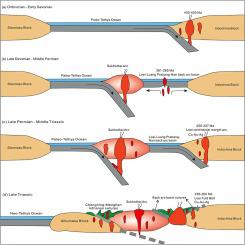Journal of Asian Earth Sciences ( IF 2.7 ) Pub Date : 2021-01-14 , DOI: 10.1016/j.jseaes.2020.104661 Meifeng Shi , Khin Zaw , Shusheng Liu , Baoci Xu , Sebastien Meffre , Feng Cong , Fei Nie , Zhimin Peng , Zhenbo Wu

|
The Loei Fold Belt is one of the most significant tectonic and metallogenic belts in the Indochina Block. However, origin and tectonic significance of volcanic rocks in several volcanic belts of this fold belt remain ambiguous. In this paper, we present new petrochemical data, zircon U-Pb ages and Lu-Hf isotopic data for volcanic rocks from the Loei Fold Belt in northwestern Laos. The basaltic and andesitic tuffaceous rocks have Late Carboniferous zircon U-Pb ages (304 ± 2.1 Ma and 299 ± 1.8 Ma respectively), and display both MORB-like and arc-like geochemical signatures. Zircon Lu-Hf isotopic analyses give highly positive εHf(t) values of 8.99–14.24, indicative of a metasomatic mantle source which formed in a back-arc basin environment. On the other hand, the andesite and rhyolite samples have zircon U-Pb ages ranging from 236 Ma to 224 Ma, erupted during the Late Triassic, and formed in a continental margin arc setting (e.g., enrichment of LREE, depletion in Nb-Ta, Sr, and positive εHf(t) values of 9.87–12.25). With a synthesis of available geochronological, petrochemical and isotopic data, magmatic events in the Loei Fold Belt occurred in four periods: Ordovician-Silurian (450–400 Ma), Late Devonian-Middle Permian (ca. 361–265 Ma), Early-Middle Triassic (250–237 Ma) and Late Triassic (ca. 236–200 Ma), with peaks in Triassic and Carboniferous. Accordingly, we propose a tectonic-magmatic evolution model for the Loei Fold Belt. The Luang Prabang-Loei belt was a spreading back-arc basin during the Late Devonian-Middle Permian, and connected with the Nan back-arc basin. The basin expanded to its largest extent in the Permian period and started subduction in the earliest Triassic; the successive subduction did not terminate until the Late Triassic.
中文翻译:

老挝西北地区石炭纪和三叠纪火山岩的年代学和岩石成因:对黎伊褶皱带构造演化的启示
黎伊褶皱带是印度支那地区最重要的构造和成矿带之一。然而,在该褶皱带的几个火山带中,火山岩的起源和构造意义仍然不明确。在本文中,我们提供了来自老挝西北部黎伊褶皱带的火山岩的新石油化学数据,锆石U-Pb年龄和Lu-Hf同位素数据。玄武质和安山质凝灰质岩具有晚石炭纪锆石U-Pb年龄(分别为304±2.1 Ma和299±1.8 Ma),并显示出MORB类和弧状地球化学特征。锆石Lu-Hf同位素分析得出高度正εHf(t)值为8.99–14.24,表明在弧后盆地环境中形成了交代地幔源。另一方面,安山岩和流纹岩样品的锆石U-Pb年龄范围从236Ma到224Ma,在三叠纪晚期爆发,形成于大陆边缘弧形环境中(例如,LREE的富集,Nb-Ta的消耗) ,Sr和正εHf(t)值9.87–12.25)。结合可用的地质,岩石化学和同位素数据,黎伊褶皱带的岩浆事件发生了四个时期:奥陶纪-西陆纪(450-400 Ma),晚泥盆纪-中二叠纪(ca. 361-265 Ma),早期-中三叠世(250-237 Ma)和晚三叠世(约236-200 Ma),在三叠纪和石炭纪具有峰值。因此,我们提出了黎伊褶皱带的构造-岩浆演化模型。琅勃拉邦-黎伊带是晚泥盆世-中二叠纪的一个扩展的弧后盆地,并与南弧后盆地相连。该盆地在二叠纪扩张到最大程度,并在最早的三叠纪开始俯冲。三叠纪晚期之前,连续的俯冲才终止。











































 京公网安备 11010802027423号
京公网安备 11010802027423号